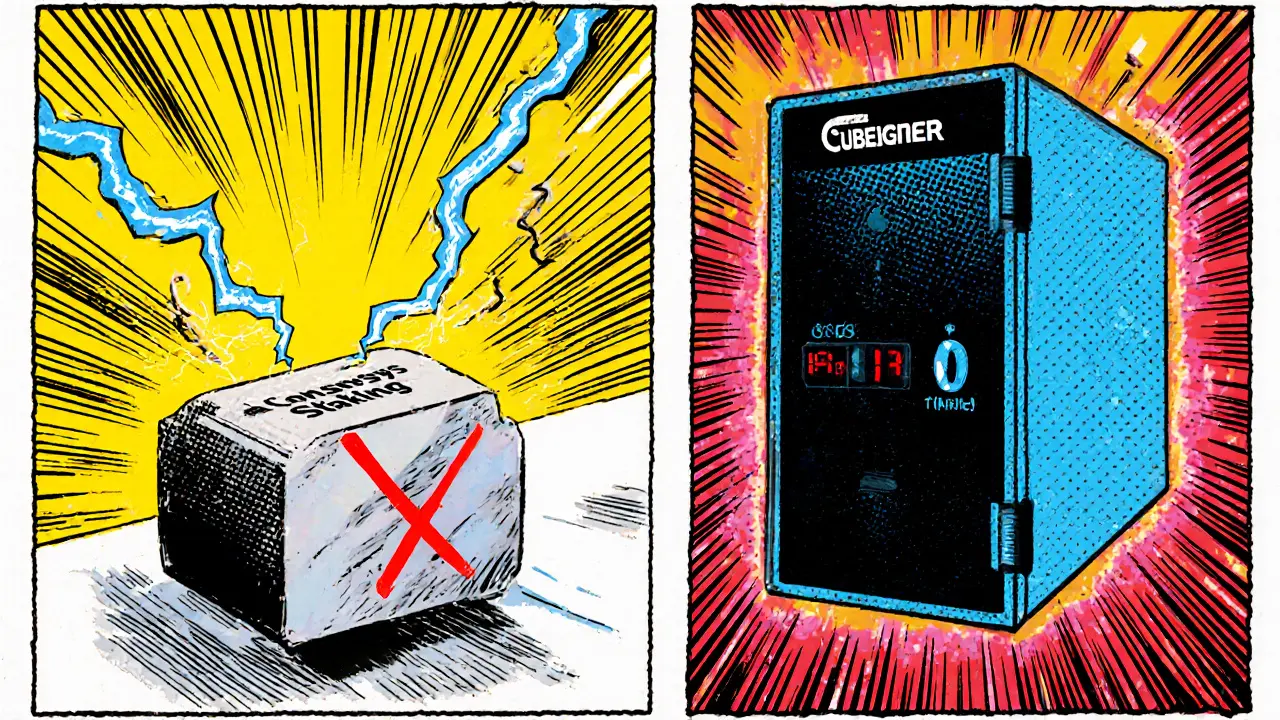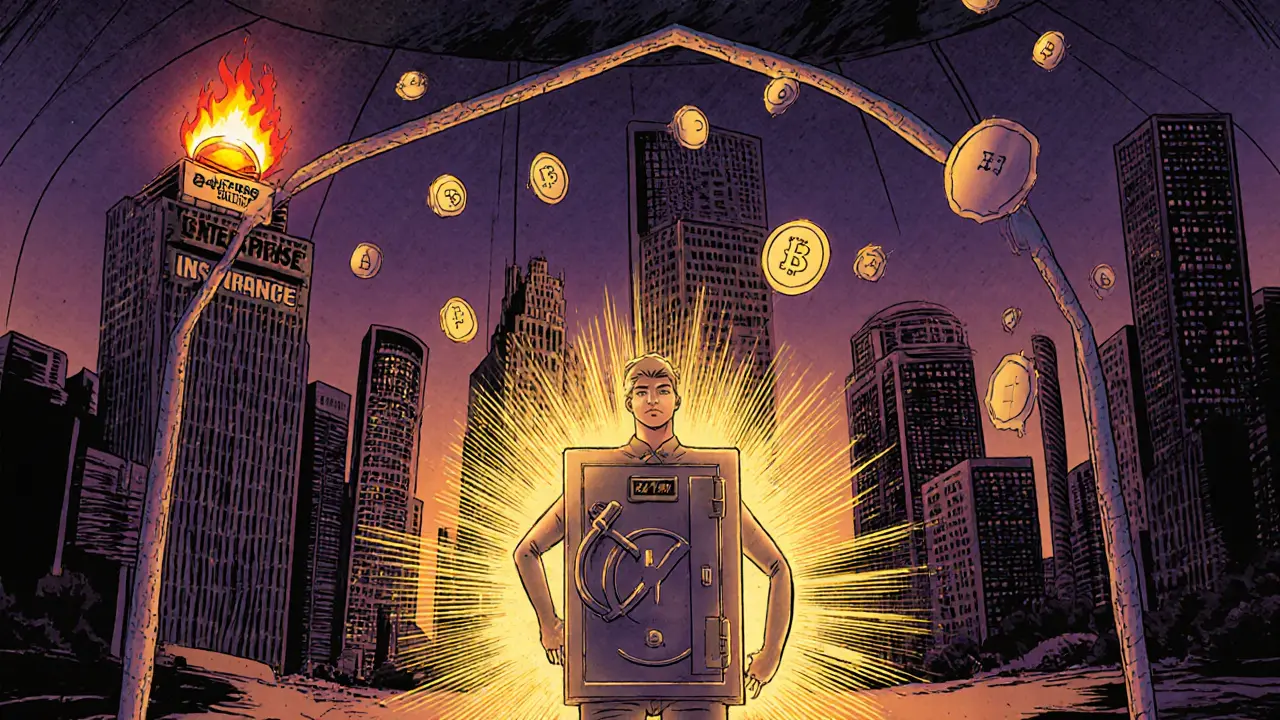
Slashing Protection Calculator
Estimated Penalty
Double Signing: Up to 5% of staked tokens. Can lead to validator eviction.
Validator Downtime: ~0.1% per missed epoch. Minor loss but affects reputation.
These penalties are applied by the blockchain protocol when violations are detected on-chain.
If you’ve ever staked tokens, the word “slashing” probably sends a chill down your spine. One mistake-double‑signing a block or going offline for too long-can erase a chunk of your stake and even lock you out of the network. The good news? You don’t have to live in fear. By understanding the mechanics behind slashing and adopting proven protection strategies, you can keep your validator humming and your funds safe.
What is Slashing?
Slashing is a penalty system built into Proof‑of‑Stake (PoS) blockchains that confiscates a portion of a validator’s staked tokens when the validator behaves maliciously or negligently. It acts as an economic deterrent, ensuring validators have “skin in the game.” In PoS networks, participants called validators nodes that propose and attest to new blocks in exchange for staking rewards are responsible for securing the chain. When they break the rules, the protocol punishes them, and the penalty is recorded on‑chain for transparency.
Common Slashing Triggers
The two most frequent causes are double signing producing two conflicting signatures for the same block slot and validator downtime failing to submit required attestations during a consensus round. Double signing is far more costly because it threatens consensus integrity, while downtime is treated as a softer fault.
| Infraction | Typical Penalty | Impact on Stake |
|---|---|---|
| Double Signing | Up to 5% of staked tokens | Significant loss; may trigger validator eviction |
| Validator Downtime | ~0.1% per missed epoch | Minor loss; reputation damage |
Understanding these numbers helps you weigh the risk of a technical glitch against the cost of keeping a backup validator online.

Why Protection Matters
Beyond the immediate financial hit, slashing undermines confidence in the whole ecosystem. When validators know they could lose assets for a single mistake, they are more likely to run highly‑available, well‑monitored setups. That, in turn, raises the overall security of the chain. For institutional stakers, a single slash can erase months of accrued rewards, making robust slashing protection a non‑negotiable component of any staking strategy.
Core Principles of Slashing Protection
The simplest rule is: never reuse the same validator key in multiple places. Duplicate keys are the most common cause of accidental double signing. Services like Consensys Staking enforce unique seed phrases for every validator, run pre‑deployment checks, and keep a ledger of recent signatures to spot conflicts before they happen.
Another key idea is “single source of truth” for signing operations. By routing all signature requests through a remote signer that logs each action, you can verify that no two conflicting messages are ever produced.

Leading Protection Solutions
Consensys Staking a staking service that generates unique validator keys, validates them, and uses Web3 Signer to guard against duplicate signatures provides a turnkey anti‑slashing stack. Their Web3 Signer maintains a history of each signature and refuses to sign anything that could lead to a slash.
CubeSigner a highly‑available key management platform that stores validator keys in hardware security modules (HSMs) sealed within AWS Nitro enclaves takes the protection a step further. By keeping the private key inside a sealed enclave, no operator-nor a compromised node-can ever extract it, eliminating the risk of inadvertent key duplication. CubeSigner also runs an anti‑slashing engine that checks every signing request against the key’s signature history, rejecting any slashable payload.
Both solutions share two pillars: secure key storage and real‑time signature validation.
Implementing Anti‑Slashing at the Protocol Level
To build your own protection, start with the specifications that define what constitutes a slashable event. Ethereum’s EIP‑3076 the anti‑slashing interface that allows validators to query past signatures before signing new ones is the de‑facto standard for many PoS chains. The Secure Staking Alliance (SSA) collaborates on cross‑chain anti‑slashing specs, ensuring that a validator can plug into a common library regardless of the underlying network.
On the hardware side, using an Hardware Security Module (HSM) a tamper‑resistant device that stores cryptographic keys and performs signing operations in a sealed environment prevents key extraction attacks. AWS Nitro Enclaves, for example, seal the key inside a lightweight VM that cannot be accessed from the host OS, satisfying the highest security audits (ISO27001:2022, SOC2TypeII).

Operational Best Practices
Even the best hardware can fail if you configure it poorly. Follow these habits:
- Do not run a backup validator with the same key. If you need redundancy, generate a brand‑new validator key for the backup node.
- Implement strict access controls: only the remote signer should have permission to use the private key.
- Monitor uptime continuously. Alert on missed attestations so you can react before penalties accumulate.
- Regularly audit your signing history. Tools that query the chain for recent signatures can surface hidden double‑sign events.
- Consider third‑party whistleblower rewards. Some networks pay a small bounty to entities that report slashable behavior, creating an extra safety net.
Adhering to these steps reduces accidental slashes to near‑zero while keeping your validator performant.
Future Outlook
As staking assets grow-now exceeding $30billion across major PoS networks-the market for enterprise‑grade slashing protection is heating up. Next‑gen solutions aim to standardize anti‑slashing APIs across chains, making it easier for small validators to plug into proven protection services without building their own HSM clusters. Expect more interoperable libraries, open‑source audit tools, and perhaps even insurance products that cover accidental slashing losses.
For anyone serious about staking, the message is clear: slashing protection isn’t optional, it’s essential. Treat it like a fire alarm system-install it before the first flame appears.
Frequently Asked Questions
What exactly triggers a slash in Ethereum?
Ethereum slashes validators for double‑signing (producing two different block signatures for the same slot) and for prolonged downtime (missing more than a defined number of attestations). The protocol checks each submitted signature against the validator’s recent history; if a conflict is found, the offending validator loses a portion of its stake, typically up to 5% for double‑signing and about 0.1% for downtime.
Can I use the same validator key on two different machines?
Never. Running the same key on multiple nodes creates a high risk of double‑signing because any slight timing difference can cause both nodes to sign conflicting messages. Services like Consensys Staking and CubeSigner enforce unique key generation to avoid this pitfall.
How does CubeSigner prevent accidental slashing?
CubeSigner stores each validator key inside an AWS Nitro enclave‑sealed HSM, meaning the key never leaves the hardware. It also runs an anti‑slashing engine that records the most recent signatures and rejects any new signing request that would create a conflict, effectively acting as a real‑time guard.
Is there any reward for reporting a slashable validator?
Yes. Many PoS networks allocate a small portion of the confiscated stake to the whistleblower who submits a valid slash proof. This incentive encourages community monitoring and helps keep the network safe.
Do I need specialized hardware to protect against slashing?
While you can implement software‑only checks (e.g., using Web3 Signer), hardware security modules or sealed enclaves dramatically lower the risk of key leakage and accidental duplicate signing. For high‑value stakes, investing in HSMs is considered best practice.






There are 15 Comments
Darren Belisle
Wow, what a solid breakdown of slashing risks!!! Keep those validators humming, and remember: regular updates, diligent monitoring, and a dash of optimism can go a long way!!!
Heather Zappella
In addition to the calculator, it's worth noting that many consensus clients now include built‑in slashing protection modules; these automatically track proposal histories and can prevent double‑signing incidents before they occur. Configuring the
--slashing-protectionflag in your client startup ensures that the node maintains a local record of signed messages, which the protocol cross‑checks against any new attestations. Moreover, some staking services offer external watch‑towers that monitor your validator's activity on the network and alert you instantly if a potential misbehaviour is detected. This layered approach-client settings, external monitoring, and regular key rotation-greatly reduces the probability of costly penalties.Brian Lisk
Implementing robust slashing protection starts with understanding the underlying mechanics of the consensus protocol, which dictates the exact conditions under which penalties are applied. Double signing, for instance, occurs when a validator equivocates by broadcasting two different blocks for the same slot, and the protocol can penalise up to five percent of the staked balance as a deterrent. Validator downtime, on the other hand, incurs a smaller but cumulative loss-approximately 0.1 % per missed epoch-which can erode returns over time if not addressed promptly. The first line of defence is to enable the native slashing protection feature provided by most Eth2 clients, as it records every signed beacon block and attestation locally. This record acts as a safeguard, preventing the client from inadvertently signing conflicting messages after a restart or a network partition. Next, consider deploying a redundant setup with a hot‑standby validator that can seamlessly take over responsibilities should the primary node experience a hardware failure or network outage. Redundancy not only improves uptime but also mitigates the risk of missed epochs, thereby protecting against the incremental penalties associated with downtime. Additionally, regular health checks-such as monitoring CPU load, disk I/O latency, and network latency-can reveal subtle performance degradations before they manifest as missed attestations. Automating these diagnostics with alerting tools like Prometheus and Grafana ensures that operators receive timely notifications, allowing for swift remediation. Key management practices also play a crucial role; rotating validator keys periodically limits the exposure window in case a private key is compromised, and using hardware security modules (HSMs) adds an extra layer of protection against illicit key extraction. Beyond technical measures, staying informed about network upgrades and consensus rule changes is essential; protocol updates can modify slashing thresholds or introduce new infractions, and being caught unaware can result in unexpected penalties. Participating in community forums and following official release notes helps operators anticipate such changes and adjust their configurations accordingly. Finally, consider performing simulated fault injections in a testnet environment to validate that your slashing protection mechanisms behave as expected under adverse conditions. By deliberately triggering double‑signing scenarios or forced downtimes, you can verify that your client correctly rejects malformed messages and that your monitoring pipeline captures anomalies. By combining client‑level protection, hardware redundancy, proactive monitoring, disciplined key management, and continuous education, you form the backbone of effective slashing mitigation, ensuring that your staking rewards are preserved while minimizing the risk of punitive losses.
Ricky Xibey
Just make sure you keep your node up‑to‑date.
Sal Sam
The consensus client’s
slashing-protectionDB utilizes a Merkle‑based history tree, so any divergence in fork‑choice logic will be flagged at the signature verification layer, preventing protocol‑level equivocation.Moses Yeo
Isn't it fascinating-while everyone obsessively polishes their slashing safeguards, the real danger lies in the unseen governance protocols that can arbitrarily retro‑adjust penalties, rendering our technical gymnastics virtually moot???
Kate O'Brien
They could be watching every validator move, and a hidden bug could turn a simple miss into a huge fine.
Richard Bocchinfuso
lol, if you ain't careful your validator's gonna get yeeted off the chain-stay sharp!
Jason Wuchenich
Remember, consistent checkpointing and backing up your slashing‑protection DB is a small habit that pays big dividends when things go sideways.
Lara Decker
The calculator's UI is barebones; without context about network conditions, its outputs risk misleading operators into a false sense of security.
Anna Engel
Oh great, another “simple” calculator that pretends to predict penalties-because blockchain economics are totally predictable, right?
manika nathaemploy
i get that slashing stuff can be scary, but with a solid monitoring setup you’ll feel a lot more chill.
Mark Bosky
It is advisable to incorporate both on‑chain and off‑chain monitoring solutions to achieve a comprehensive view of validator performance; this dual approach facilitates early detection of anomalies and enhances overall system resilience.
Marcus Henderson
In the grand tapestry of decentralized consensus, slashing serves as both a deterrent and a moral compass, reminding participants that security and responsibility are intertwined threads that must be woven with deliberate care.
Debra Sears
What strategies have you found most effective for balancing uptime with the overhead of maintaining redundant infrastructure?
Write a comment
Your email address will not be published. Required fields are marked *